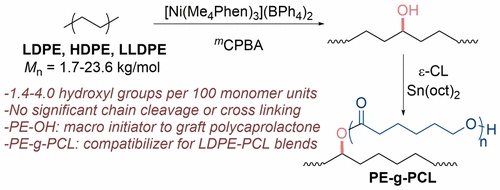Catalytic Hydroxylation of Polyethylenes

Polyolefins account for 60% of global plastic consumption, but many potential applications of polyolefins require that their properties, such as compatibility with polar polymers, adhesion, gas permeability, and surface wetting, be improved. A strategy to overcome these deficiencies would involve the introduction of polar functionalities onto the polymer chain. Here, we describe the Ni-catalyzed hydroxylation of polyethylenes (LDPE, HDPE, and LLDPE) in the presence of mCPBA as an oxidant. Studies with cycloalkanes and pure, long-chain alkanes were conducted to assess precisely the selectivity of the reaction and the degree to which potential C–C bond cleavage of a radical intermediate occurs. Among the nickel catalysts we tested, [Ni(Me4Phen)3](BPh4)2(Me4Phen = 3,4,7,8,-tetramethyl-1,10-phenanthroline) reacted with the highest turnover number (TON) for hydroxylation of cyclohexane and the highest selectivity for the formation of cyclohexanol over cyclohexanone (TON, 5560; cyclohexanol/(cyclohexanone + ε-caprolactone) ratio, 10.5). The oxidation of n-octadecane occurred at the secondary C–H bonds with 15.5:1 selectivity for formation of an alcohol over a ketone and 660 TON. Consistent with these data, the hydroxylation of various polyethylene materials by the combination of [Ni(Me4Phen)3](BPh4)2 and mCPBA led to the introduction of 2.0 to 5.5 functional groups (alcohol, ketone, alkyl chloride) per 100 monomer units with up to 88% selectivity for formation of alcohols over ketones or chloride. In contrast to more classical radical functionalizations of polyethylene, this catalytic process occurred without significant modification of the molecular weight of the polymer that would result from chain cleavage or cross-linking. Thus, the resulting materials are new compositions in which hydroxyl groups are located along the main chain of commercial, high molecular weight LDPE, HDPE, and LLDPE materials. These hydroxylated polyethylenes have improved wetting properties and serve as macroinitiators to synthesize graft polycaprolactones that compatibilize polyethylene–polycaprolactone blends.
Read more on publisher's site.